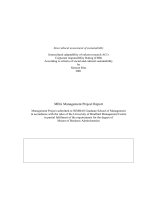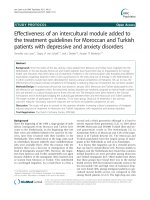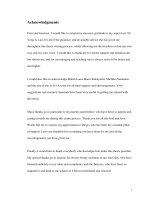INTERCULTURAL COMMUNICATION-TOPIC 4-COMPLAINING
Bạn đang xem bản rút gọn của tài liệu. Xem và tải ngay bản đầy đủ của tài liệu tại đây (14.23 MB, 23 trang )
LOGO
1
INTERCULTURAL COMMUNICATIONINTERCULTURAL COMMUNICATION
Topic 4: Complaining
Group 7_Class QH10.E14
1. Ngô Thʈ Diʂm
2. Nguyʂn Thʈ Thɠo
3. Trɤn Quang Sơn
4. Nguyʂn H͓ng Nhung
2
CONTENTS
I. THEORETICAL BACKGROUND
1. The speech act theory
2. Complaint as a speech act
II. OUR OWN STUDY
1. Survey Description
2. Figures and Findings
3. Implications
3
I. THEORETICAL BACKGROUND
1. The speech act theory
a. Definition
Speech act is a unit of speaking and each
unit performs certain functions in
interaction such as request, invitation,
complaint, compliment, prohibition, etc.
4
I. THEORETICAL BACKGROUND
b. Classification (Austin_1662)
Locutionary
acts
1 2
Illocutionary
acts
Representatives
Directives
Commissives
Expressives
Declaratives
3
Perlocutionary
acts
5
I. THEORETICAL BACKGROUND
2. Complaint as a speech act
a. Definition
Complaint is defined as an illocutionary
act in which the complainer shows his/her
disapproval, negative feelings, etc. to an
event to ask the complainee for either
direct or indirect responsibility.
(Trosborg-1995:310)
Ex: ³Next time don¶t expect me to sit
here waiting for you!´
6
b. Complaint strategies
I. THEORETICAL BACKGROUND
No explicit
reproach
Expression of
annoyance
Accusation
Blame
7
I. THEORETICAL BACKGROUND
b. Complaint strategies
Trosborg (1995) outlines 4 main complaint
strategies which are very similar to those
offered by Olshtain and Weinbach.
i. No explicit reproach ± Category I
Strategy 1: Hint
Ex: ³All right, don¶t see much of you
these day, do I?´ (Trosborg, 1995:339)
I. THEORETICAL BACKGROUND
ii. Expression of annoyance or
disapproval ± Category II
Strategy 2: Annoyance
Ex: ³You know, we agreed to be quiet after
11 p.m, don¶t you?´ (Trɤn Thʈ Vân Dung)
Strategy 3: Consequences
Ex: ³I wil l take hours to rearrange these!´
8
I. THEORETICAL BACKGROUND
iii. Accusation ± Categogy III
Strategy 4: Indirect accusation
Ex: ³You borrowed my car last night,
didn¶t you?´
(Trosborg, 1995:319)
Strategy 5: Direct accusation
Ex: ³Did you happen to bump into my
car?´
(Trosborg, 1995:319)
9
I. THEORETICAL BACKGROUND
iv. Blame ± Category IV
Strategy 6: Modified blame
Ex: ³Couldn¶t you been more careful?´
(Trosborg, 1995:319)
Strategy 7: Explicit blame
(behaviour)
Ex: ³Oh, no! Look at what you have done!´
Strategy 8: Explicit blame (person)
Ex: ³Bloody fool! You¶ve done it again!´
(Trosborg, 1995:319)
10
I. THEORETICAL BACKGROUND
c. Directive acts
i. Request for repair
Ex: ³Could you please be a little bit
quieter?´ (our data)
ii. Threat
Ex: ³If we don¶t finish job today, I¶ll have
to discuss it with the boss´
iii. Request for forbearance
11
12
II. OUR OWN STUDY
1. Survey description
The research is conducted through a survey
questionnaires on 34 people, including 17
Vietnamese people and 17 Anglicist people.
Anglicist interviewees are around the age of
20-60+. They are visiting Vietnam.
Vietnamese interviewees are around the age
of 18-60+. They are living and studying or
working in Hanoi.
II. OUR OWN STUDY
2. Situations
What would you say?
a. Situation 1:
Your close friend were late for your appointment.
13
II. OUR OWN STUDY
2. Situations
What would you say?
b. Situation 2:
At a library. Two other students were
talking loudly while you needed
quietness for reading.
14
II. OUR OWN STUDY
2. Situations
What would you say?
c. Situation 3:
At your favorite restaurant. The food
didn¶t taste as good as usual.
15
II. OUR OWN STUDY
10.71
20.57
3.57
21.43
35.71
0
5
10
15
20
25
30
35
40
Category 1
Category 2
Category 3
Category 4
Category 5
Category distribution in Vietnamese
16
3.Figures
II. OUR OWN STUDY
As can be seen, the most frequently
used category seems to be Cat. 5,
Directive Acts, which holds 35.71%.
The second is Cat. 4, Blame which
holds 21.43%.
The third one tends to be Cat. 2,
Expression of Annoyances which
comprises 20,57%.
The fourth and the fifth is No Explicit
Reproach and Accusations
respectively.
17
18
II. OUR OWN STUDY
3. Figures
16.33
30.61
14.29
8.16
30.61
0
5
10
15
20
25
30
35
Category 1
Category 2
Category 3
Category 4
Category 5
Category distribution in English
II. OUR OWN STUDY
The most common categories are
Directive Acts and Expression of
Annoyance (30,61% each).
The third is No explicit Reproach,
which holds 16.33%.
The fourth is Accusation which
consists of 14,29% and the least
common category is Blame, which
accounts 8.16%.
Blame < Accusations <No explicit
Reproach <Directive Acts, Expression of
Annoyance.
19
II. OUR OWN STUDY
4. Findings
a. Similarities
The two most common categories in both
languages are Explicit of Annoyance and
Directive acts
b. Differences
It is refered that Vietnamese people tend to be
more direct when complaining.
The total percent of Cat.4 and Cat.5 in
Vietnamese is higher than it in Anglicist
(57% and 38%)
20
21
II. OUR OWN STUDY
c. Structures and expressions
English
Vietnamese
- I have a complaint to
make
- Sorry to bother you but
- I'm sorry to say this but
- I'm afraid I've got a
complaint about
- I'm afraid there is a slight
problem with
- Excuse me but there is a
problem about
- I want to complain about
- I'm angry about
- Cái này khó quá!
- Tôi không thích cá i này
- Khʆ thɪt!
- Tôi không mu͑n «
- Chɰng hay ho gì!
- Khiɼp lên đưͣc!
- Làm gì mà lɾ mɾ thɼ!
- ͒n ào quá!
- Làm ơn giͯ vʄ sinh m͙t
chút đi!
II. OUR OWN STUDY
22
d. Implication
Understand the use of directness and
indirectness strategies in Anglicist
culture and Vietnamese culture
Improve your complaining skills
Understand the language Anglicist
people often use to make a complaint in
direct and indirect way.
23









